Class 6 Important Questions for Science – Getting to Know Plants
NCERT Exemplar Class 6 Science is very important resource for students preparing for VI Board Examination. Here we have provided NCERT Exemplar Problems Solutions along with NCERT Exemplar Problems Class 6.
Question from very important topics are covered by NCERT Exemplar Class 6. You also get idea about the type of questions and method to answer in your Class 6th examination.
Here you can get Class 6 Important Questions Science based on NCERT Text book for Class VI. Science Class 6 Important Questions are very helpful to score high marks in board exams. Here we have covered Important Questions on Getting to Know Plants for Class 6 Science subject.
Science Important Questions Class 6 are given below.
Multiple Choice Questions
- Which of the following combination of features would you observe in grass?
- (a) Parallel venation and fibrous root
- (b) Parallel venation and tap root
- (c) Reticulate venation and fibrous root
- (d) Reticulate venation and tap root
- Which of the following is the correct match between the characteristics of stem and the category of plant?
- (a) weak stem which cannot stand upright: Creeper
- (b) green tender stem : Shrub
- (c) thick, hard stem with branching near the base : Tree
- (d) thick, hard stem with branches high on the plant : Herb
- Which of the following is not the primary function of stem?
- (a) Conduction of water
- (b) Photosynthesis
- (c) Formation of branches
- (d) Bears flowers and fruits
- Which of the following is not a correct match?
- (a) Petiole : attaches leaf to stem
- (b) Lamina : green flat part of leaf
- (c) Margin : gives shape to the leaf
- (d) Veins : transpiration
- Read the following sentences about photosynthesis:
(i) Sunlight, carbon dioxide, chlorophyll and water are necessary.
(ii) Oxygen is absorbed.
(iii) Leaves carry out photosynthesis.
(iv) Proteins are made during photosynthesis.
Choose the correct pair of sentences that are true to photosynthesis- (a) (iii) and (iv)
- (b) (i) and (iii)
- (c) (ii) and (iv)
- (d) (i) and (iv)
- Which of the following terms constitute the female part of the flower.
- (a) sepals, petal and stamen
- (b) stigma, style and ovary
- (c) ovary, stamen and stigma
- (d) ovary, style and stamen
Very Short Answer Type Questions
- Fill in the blanks:
- (a) The small green leaves at the base of flowers are known as ————.
- (b) The swollen basal part of the pistil is the —————– which bears the ———-.
- (c) Stamen has two parts called ————- and ————.
- (d) The young unopened flower is termed as ————-.
- Solve the riddles given below:
- (a) “I have a green tender stem and I am much shorter than you. Who am I?”
- (b) I come out first from the seed when it is soaked in water.
I provide anchorage to plants. Who am I? Write another function that I perform.
Short Answer Type Questions
- Match the parts of plant given in Column I with their function in Column II

- Boojho wanted to test the presence of starch in leaves. He performed the following steps.
- (1) He took a leaf and boiled it in water,
- (2) He placed the leaf in a petri dish and poured some iodine over it.
He did not get the expected result. Which step did he miss? Explain.
- Will a leaf taken from a potted plant kept in a dark room for a few days turn blue black when tested for starch? Give reasons for your answer.
- Can the stem of a plant be compared with a street with two–way traffic? Give reason.
Long Answer Type Questions
- Read the function of parts of a plant given below:
- (a) fixes plant to the soil
- (b) prepares starch
- (c) takes part in reproduction
- (d) supports branches and bears flowers
In the diagram given in Fig. 7.1, write the names of the parts whose functions you have just read at the appropriate space.
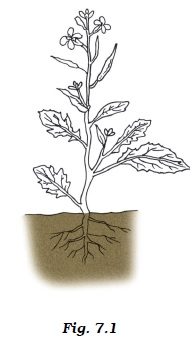
- Draw the veins of leaves given in Fig. 7.2 below and write the type of venation.
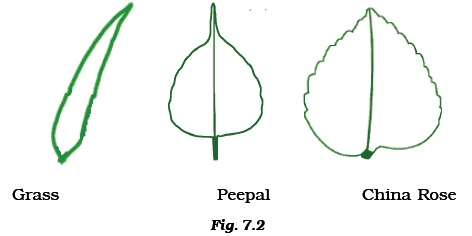
- Observe Fig. 7.3 and attempt the questions that follow it.
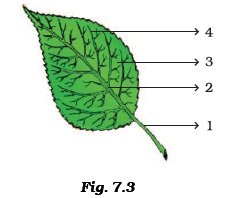
- (a) Label the parts 1, 2, 3 and 4 in the diagram.
- (b) What type of venation does the leaf has?
- (c) What type of venation is seen in grass leaves?
- Observe the picture of an activity given as Fig. 7.4 carried out with leaves of plants and polythene bag.
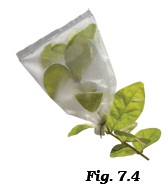
Now answer the following:- (a) Which process is demonstrated in the activity?
- (b) When will this activity show better results – on a bright sunny day or a cloudy day?
- (c) What will you observe in the polythene bag after a few hours of setting up the activity?
- (d) Mention any one precaution you must take while performing this activity.
- Identify the wrong statements and correct them.
- (a) Anther is a part of the pistil.
- (b) The visible parts of a bud are the petals.
- (c) Lateral roots are present in a tap root.
- (d) Leaves perform the function of transpiration only.
- Solve the crossword given in Fig. 7.5 as per the clues given below it:
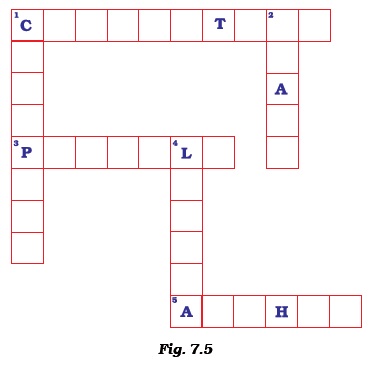
Across- 1. The term that describes upward movement of water in a stem.
- 3. The part of leaf which is attached to the stem.
- 5. This part is attached to the tip of filament.
Down
- 1. Plants that are weak and spread on the ground.
- 2. Ovules are present in this part of flower.
- 4. Is the broad part of leaf.
- Fill in the blanks with the terms that are listed below:
anther, male, ovary, ovule, petals, pistil, stamen, filament.

| « Previous | Next » |
Answers to Multiple Choice Questions
| 1. a | 2. a | 3. b | 4. d |
| 5. b | 6. b |
Class 6 Important Questions for Science all topics
Science Important Questions Class 6 are given below chapter wise.
- Food : Where Does it Come From ?
- Components of Food
- Fibre to Fabric
- Sorting Materials and Groups
- Separation of Substances
- Changes Around Us
- Getting to Know Plants
- Body Movement
- The Living Organisms and their Surroundings
- Motion and Measurement of Distances
- Light
- Electricity and Circuits
- Fun with Magnets
- Water
- Air Around Us
- Garbage In, Garbage Out
Other Study Material
To get study material, exam alerts and news, join our Whatsapp Channel.


